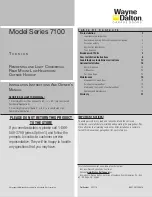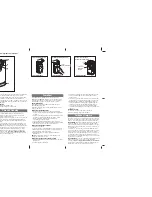
RAINBOW 324 C - RAINBOW 524 C - RAINBOW 724 C
ENGLISH
Guide for the installer
Page 8
2. ELECTRICAL PREPARATIONS (standard system)
With reference to
fi
g. 4:
Pos.
Description
Cable section
Operator (power supply)
3x1.5 mm
2
TX photocell
2x0.5 mm
2
RX photocell
4x0.5 mm
2
Key-selector
2x0.5 mm
2
To lay cables, use adequate rigid and/or
fl
exible tubes
Always separate connection cables of low-voltage acces-
sories from power cables. To prevent any interference
whatsoever, use separate sheaths.
3. INSTALLING THE AUTOMATED SYSTEM
3.1. PRELIMINARY CHECKS
To ensure safety and an ef
fi
ciently operating automated system,
make sure the following conditions are observed:
• When moving, the beam must not, on any account, meet any
obstacles or overhead cables.
• The soil must permit suf
fi
cient stability for the foundation plinth.
• There must be no pipes or electrical cables in the plinth exca-
vation area.
• If the barrier body is exposed to passing vehicles, install, if pos-
sible, adequate means of protection against accidental impacts.
• Check that an ef
fi
cient earth socket is available for connecting
the upright.
3.2. MASONRY FOR FOUNDATION PLATE
1.
Assemble the foundation plate as shown in
fi
g. 5.
2.
Make a foundation plinth as shown in
fi
g. 6.
Plinth dimensions must be adequate for the type of in-
stallation and soil.
3.
Wall the foundation plate as shown in
fi
g. 6, supplying one or
more sheaths for routing electrical cables.
The rounded part of the foundation plate must face the
internal part of the passage to be automated.
4.
Using a spirit level, check if the plate is perfectly level.
5.
Wait for the cement to set.
3.3. MECHANICAL INSTALLATION
1.
Remove the 4 upper nuts from the foundation plate.
2.
Remove both screws securing the upper cover, see Fig.7, ref.
.
3.
Fit the release key into the lock of the cover, Fig. 8, and turn it
clockwise until it stops.
4.
Keeping the key in this position, remove the upper cover, Fig. 8.
5.
Remove the panel as shown in
fi
g. 9.
6.
Place the upright on the four threaded tie-rods as shown in
fi
g.
10 and tighten the four
fi
xing nuts.
7.
Prepare the automated system for manual operation, see pa-
ragraph 7
8.
Place the spring rod, Fig. 11 ref.
, horizontally.
9.
Secure the spring plate, as shown in
fi
g. 12, according to the
closing direction:
• If the rod closes to the left of the upright, right hand installation,
the plate must be secured on pin
,
fi
g.11.
• If the rod closes to the right of the upright, left hand installation,
the plate must be secured on pin
,
fi
g. 11.
10.
Turn the spring plate to the position shown in
fi
g. 13, according
to the installation type (right hand or left hand).
11.
Place the rod plate in the front part of the automated system
keeping it horizontally, Fig. 14.
For the RAINBOW 724 C model, pay attention to the orien-
tation of the holes indicated in Fig. 14 ref.
: the holes must
be on the plate top part.
12.
Secure the rod plate using relevant screw, lock washer and
washer, Fig.15.
3.4. ASSEMBLING THE ROD
To assemble the rod, you should remember that:
• The rubber edge, with the rod in closing position, must face the
ground.
• The hole on the rod must be coupled with the pin coming out of
the driving plate.
Operate as shown in
fi
g. 16.
1.
Place the cheek plastic Fig. 16 ref.
, as shown.
2.
Place the rod on the central pin with the rubber edge faced
downward.
3.
Place the
fi
xing pocket,
fi
g. 16 ref.
, and secure it using the
supplied screws.
Pay attention to the orientation of the holes,
fi
g. 16 ref.
,
in correspondence with the holes on the rod plate.
4.
Assemble the cover as shown in
fi
g. 17, according to the type
of automated system and installation (left hand or right hand).
5.
Secure the cover as shown in
fi
g. 18.
3.5. INSTALLING AND ADJUSTING THE BALANCING
SPRING
To operate correctly, the automated system must be equipped
with one or two balancing springs that must be ordered separately
according to the automated system model, to the rod type and to
any selected accessories.
To install and adjust the spring, follow the instructions below:
1.
Move the beam into vertical position and prepare the automated
system for normal operation, see paragraph 8. Make sure that
the rod cannot be moved by hand.
2.
Place the spring or the springs in the spring plate as shown
in
fi
g. 19.
3.
Place the other spring plate and its relevant tie-rod,
fi
g. 20 ref.
and
on the other end of the spring; secure the whole
part in the hole on the upright. Fit the
fi
xing nut,
fi
g. 20 ref.
.
4.
Tighten the nut,
fi
g. 20 ref.
, to eliminate any spring clearance.
5.
Prepare the automated system for manual operation adjusting
the release device as shown in paragraph 7.
6.
By means of the bottom nut, Fig. 20 ref.
, start to tension
the spring.
The spring is correctly tensioned when, after having po-
sitioned the rod to 45°, it stands still.
7.
After you have adjusted the spring, block the tie-rod position
tightening the counter-nut,
fi
g. 20 ref.
.
3.6. ADJUSTING THE MECHANICAL STOPS
Two mechanical stops are provided on the upper part of the
upright, Fig. 21 ref.
and
.
To adjust the position of the stops, operate as follows:
1.
Manually move the rod into closing position.
2.
Loosen the
fi
xing nuts,
fi
g. 21 ref
.
3.
Using the screw, move the rod into horizontal position.
4.
Tighten the
fi
xing nut.
5.
Move the rod into vertical position and do the same for the
other mechanical stop.
We recommend you to grease both mechanical stops pe-
riodically.
3.7. ADJUSTING THE TRAVEL LIMIT DEVICES
Two travel limit devices are located on the automated system to
identify the rod position, open or closed, Fig. 22.











































